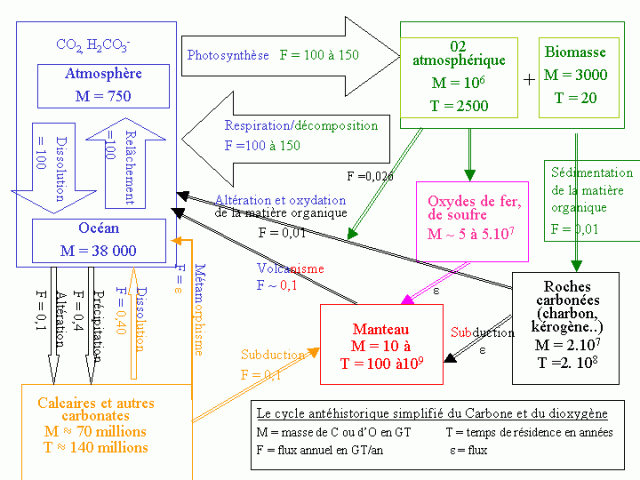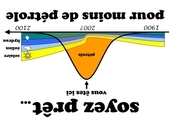
The Earth is well made: respiration and photosynthesis cancel each other out ...
There is obviously a lack of fossil fuels since this is the ... natural cycle.
Source and (much) more info: http://acces.inrp.fr/acces/ressources/C ... tho_point3



2.The HCO2- CO3 CO3 cycle
2.1 Precipitation and dissolution of carbonates.
These exchanges involve considerable masses of carbon. For example, the Urgonian in the Alps is a layer of limestone which occupies about 300 km by 50 km. A simple calculation shows that this layer contains around 3300 Gt of CO2, more than the 2750 Gt of atmospheric CO2 currently. However, this layer was deposited in only 5 million years, in a very small region of the world. As another example, Pierre THOMAS calculates that in 1,6 million years, the Rhône brings to the sea as much CO2 in the form of HCO3- as the atmosphere contains. However, these exchanges are reversible and balanced in the very long term, and do not lead to permanent modification of the composition of the atmosphere.
2.2. Alteration of silicates.
This reaction, however, is irreversible (cold), and extremely important. To illustrate, Pierre Thomas presents the consequences of the erosion of the Himalayas. This young chain has been subject to erosion and alteration for 20 million years. The alteration of the Himalayan silicates leads to the formation of carbonate rocks in the submarine deltas of the Ganges and the Indus. A simple calculation shows that this phenomenon alone consumed 20 Gt of CO62000 in 2 million years, 22 times the current atmospheric CO2 or 44% of the CO2 in the oceans. The erosion of the Himalayas can thus be held responsible for the slowing down of the greenhouse effect and the cooling of the climate for 20 million years, with the appearance of glaciers in Antarctica then in Greenland and in the Northern Hemisphere especially since 2 million years.
2.3. Metamorphism, subduction and volcanism.
The alteration of silicates, irreversible when cold, is however reversible when hot. After the subduction of limestones and organic matter, the reverse reaction occurs and produces silicates and CO2, which resurface later due to volcanism. Thus, a resumption of orogenesis and alteration cause a drop in atmospheric CO2, while an acceleration of volcanism, as for example in the Upper Cretaceous leads to an increase in CO2.
3. CO2 cycle - Organic matter - O2
3.1. Photosynthesis and respiration
By comparison with the phenomena mentioned above, this cycle is very short, 7 years on average. The flows of 100 to 150 Gt / year are 200 times greater than the precipitation of carbonates for example. But contrary to common opinion, this cycle does not globally produce oxygen. Pierre Thomas corrects the common belief of the general public that "forests produce oxygen".
Pierre Thomas presents the annual balance sheet of a birch forest in North America: activity slowed down in winter, net production of oxygen and CO2 consumption from May to July (dominant photosynthesis) then net consumption of oxygen and release of CO2 during summer and fall (dominant breathing). The annual balance is balanced. The annual variations in atmospheric CO2, directly linked to the northern hemisphere where most forests are found, illustrate the fact.
3.2. Origin of the dioxygen we breathe.
If the photosynthesis of current forests does not produce O2, where does the O2 we breathe come from?
Old photosynthesis, but when (and only when) it was followed by fossilization and sedimentation of organic matter. Each time 12 g of organic C is fossilized, the 32 g of O2 (by-product of photosynthesis which produced these 12 g) were not reused by respiration and decomposition, and they accumulated in the atmosphere. Today we breathe oxygen that has been generated over geological ages by the accumulation of carbonaceous rocks. If there had not been sedimentary traps to accumulate carbonaceous rocks there would be only 8000 Gt of oxygen in the atmosphere to ensure respiration.
The presence of atmospheric O2 essential to current life therefore has a biological (photosynthesis) and geological (sedimentary traps) origin.
Carbonaceous rocks also deteriorate. When a black marl comes to the surface, for example due to erosion, it oxidizes. The oxidation of black marl consumes oxygen and generates CO2. This carbon stock therefore "rotates" too, but it "rotates" very slowly.

I have often read or heard many inaccuracies or see errors in the CO2 cycle compared to hydrocarbons and biofuels. If it is wrong to say that biofuels do not release CO2, their cycle is not the same as that of hydrocarbons. I propose to explain this to you briefly.
Comparative explanation of the CO2 cycles of biofuels and hydrocarbons
First of all, it is good to recall this basic premise: CO2 is naturally present in the atmosphere where it plays a primordial role in regulating exchanges between the earth and its environment.
(...)
Between a biofuel and a fossil energy, the exchanges of CO2 with the amosphere are different:
* Biofuels: During its growth, the plant captures CO2 in the atmosphere and uses it to grow via the Photosynthesis process.
During the combustion of the biofuel from this plant, the CO2 that was captured during the growth is released into the atmosphere.
We are therefore facing a short cycle: the CO2 captured during growth is released during combustion, that is to say some time after (1 month for example) and will be recaptured during the growth of the future generation of plant which will be used to make biofuel. The CO2 from biofuels therefore remains in the atmosphere only for the duration: combustion when the plant grows, ie a few months. Which is very short geologically speaking.
Note that wood-based heating or energy generation systems also follow a short cycle (even if it is longer than for biofuels).
* Fossil fuels: hydrocarbons, coal and natural gas: Plants that grew millions of years ago, in the same way as today, extract part of the CO2 from the atmosphere.
They did not burn (therefore did not return to the atmosphere the CO2 they had taken there) but died and then, through a succession of geological phenomena, turned into hydrocarbons, coal or natural gas.
We therefore find the result of millions of years of CO2 capture by billions of plants. And therein lies the rub: these phenomenal quantities of CO2 pumped into the atmosphere for millions of years are released into the atmosphere in a very short time, around two centuries of exploitation for petroleum. There is therefore an enormous desynchronization of the capture and restitution cycles that the atmosphere cannot manage.
is to be changed to:If there had not been sedimentary traps to accumulate carbonaceous rocks there would be only 8000 Gt of oxygen in the atmosphere to ensure respiration.

dedeleco wrote:...
These are not theoretical simulations, but real reality, which occurred on earth, under the same conditions, measured by various geological studies which give the sea level and the concentration of CO2, thanks to the various fossils.
The rise of the seas has reached actually in the past, after glaciation, speeds of 4m per centuries, that is to say countries like the Netherlands, Bangladesh or cities like New York submerged in just one life !!
We leave this future certain for our children now.

dedeleco wrote:......
By adding all the other forms of carbon fuel with C possible, it is clear that we have much more fossil fuel than to burn all the oxygen we breathe !!
So the peak oil, or rather the peak of fossil fuels, is a pure illusion, linked to its price, and to speculation on the ease of extracting it ...

Especially if consumers leave (China, India ...)
Back to "Climate Change: CO2, warming, greenhouse effect ..."
Users browsing this forum : Google [Bot] and 125 guests